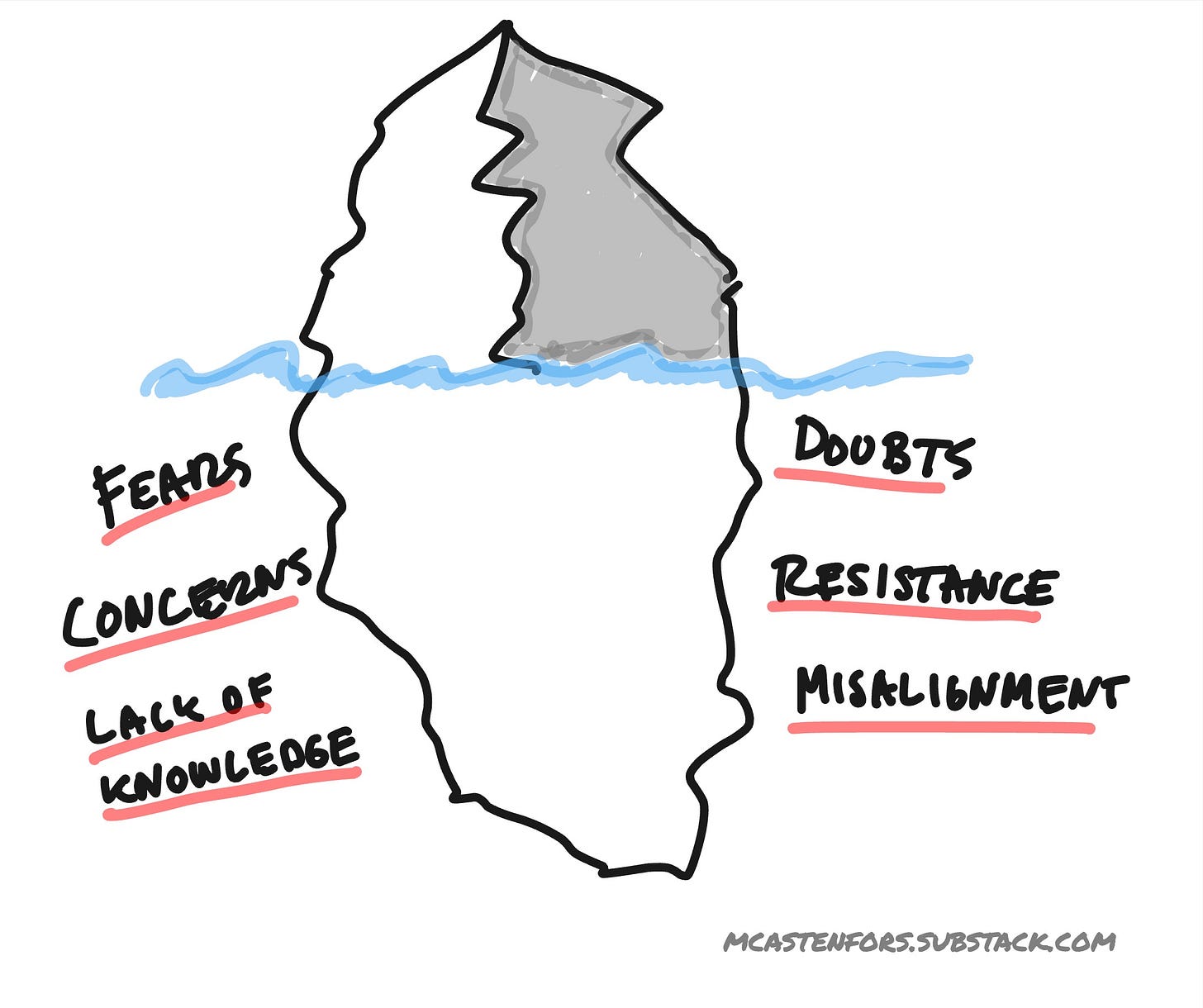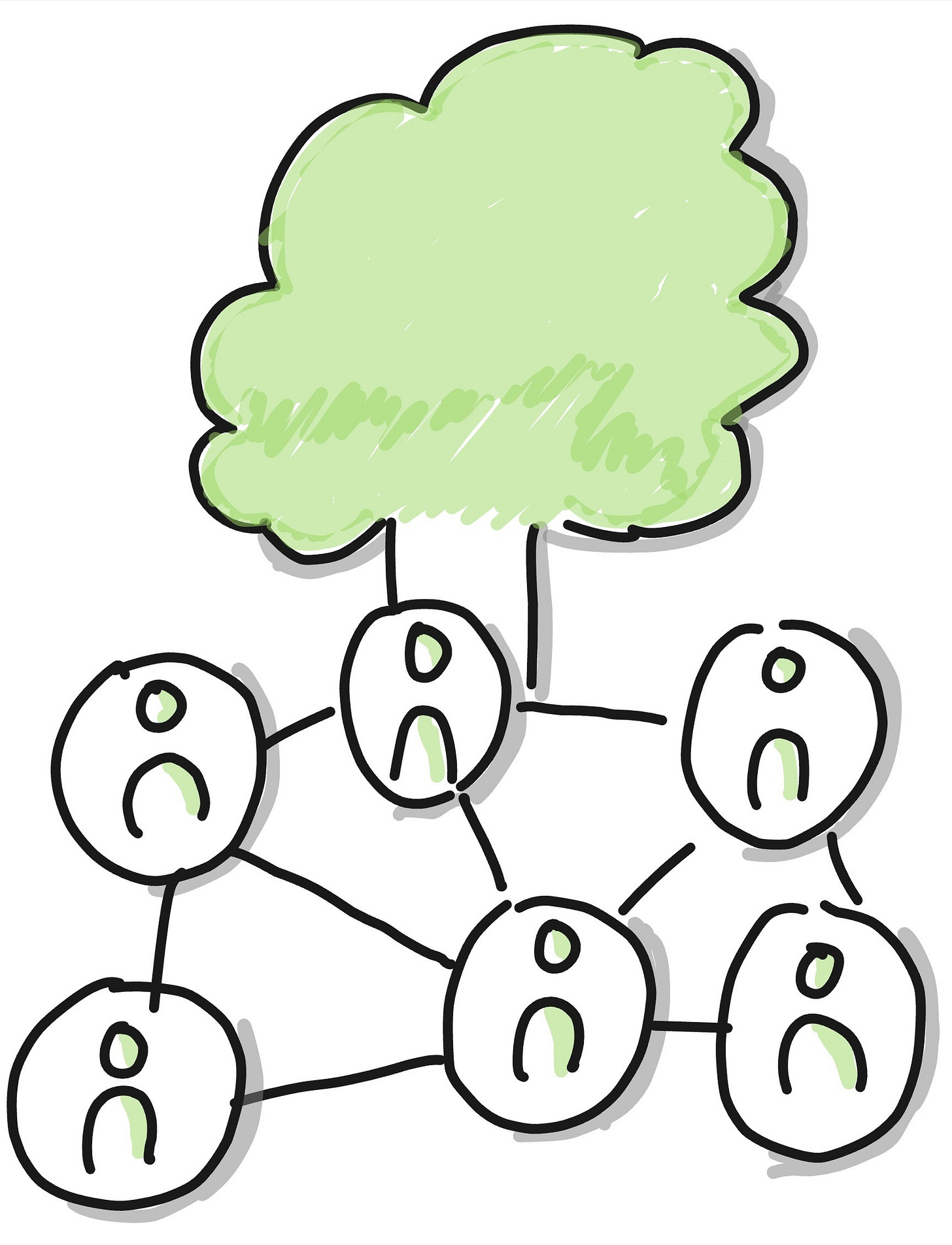Anti-pattern #10: Leaders talk the talk but don't walk the walk
If leaders don’t embody the change, teams won’t either.
There was a huge elephant in the room—the kind everyone sensed but pretended didn’t exist.
The executive team had read the books, discussed the concepts, and even brought in outside speakers. They nodded along, exchanging uncomfortable laughs as they reflected on their inefficiencies.
“We don’t talk to each other.”
“We hardly have any common direction.”
“We’re so slow.”
When the CPO got the green light to start the transformation to the product model, it looked like alignment had been reached. But beneath the surface, Doubters lurked.
The VP of Sales thought, I don’t really understand all these new terms. But if I don’t get the features I need to hit my sales quota, I’ll escalate.
The VP of Marketing had similar concerns. The website needs fixing. My list of must-haves can’t wait.
Behind the nods and smirks, a “let’s wait and see” mentality took hold. The tough conversations about how this change would fundamentally reshape the company hadn’t happened. The unspoken assumption in the room: This is just an IT thing. It’ll make developers happier, but it won’t change how we do business.
This hesitation at the top trickles down across the organization. The symptoms appear quickly:
Projects get labeled as “strategies.”
Updating the team topology is pushed to the future.
Hiring for critical roles like product designers and data scientists is de-prioritized.
At its core, leaders avoid making tough calls. They drag their feet on necessary changes, leave conflicts unresolved, tolerate resistance, and fail to support the people driving the change.
The elephant in the room remains unchallenged. And what happens as a result? The transformation gets stuck with a flat tire before it even hits the road.
To illustrate this anti-pattern further, here are two scenarios that show it in action—and what you can do to prevent it.
The CPO who didn’t want to make the tough calls
Momentum was strong. The company had raised multiple rounds, the founders were speaking at prestigious startup conferences, and the CPO was widely respected for their product sense and creativity. They had built a track record of launching successful products.
As the company scaled, the founders realized they couldn’t run things the way they used to. They needed to empower teams to move faster and scale. Every quarter, more teams were onboarded.
And then, the cracks started to show.
The newly hired head of design and a long-time product director couldn’t stand each other. Their ways of working clashed. The head of design was a firm believer in research, thorough problem-solving, and collaboration. The product director, on the other hand, lived by one mantra: “Launch and learn.”
The product director saw themselves as the visionary who always had the right answers. They were credited with past successes and known for working tirelessly. But there was another side. They dismissed feedback, resisted collaboration, and believed process and research were just red tape that slowed things down. In their mind, involving others wasn’t just unnecessary—it was a waste of time.
Every meeting between the two of them turned into a heated exchange:
“This is madness. You don’t even know what the customers need.”
“All you want is to overcomplicate everything. I’m fed up.”
The conflict spread across the company. Designers and PMs hesitated to collaborate. Silos began to form.
The CPO avoided making a call, unwilling to confront the product director’s behavior because of their track record in the company. Instead of addressing the conflict head-on, the CPO brought in external consultants to teach “design thinking” to PMs and reassigned the product director to another area, hoping the tension would fade on its own. It didn’t.
It didn’t change a thing.
A year later, the same tensions remained. Growth had stalled. People were quitting. There was an overarching confusion in the organization: should we listen to the designers or the product organization? Which way of working is valued the most?
What’s the lesson here? The CPO wasn’t willing to make the tough calls to address unwanted behavior and misalignment. Instead of stepping in, they let the dysfunction spread—hoping it would resolve itself rather than taking action.
And that hesitation cost them greatly.
The CTO who didn’t want to change
Frustration had been bubbling for a while. The CTO, deeply passionate about the mission and the product, was involved in everything—whether it was a critical production bug or picking the office birthday cake.
For years, this had been their superpower. Employees admired their technical expertise. When you had a problem, the CTO would take time to help, providing a solution—or three.
But that was also the problem.
Ideas for new features didn’t come from teams. They came from the CTO’s late-night tinkering. The next morning, priorities would shift based on their latest idea. The roadmap was a moving target, dictated by the CTO’s instincts rather than market insights.
At first, teams followed orders. But as the company grew, people started pushing back.
A PM suggested giving teams autonomy to drive product discovery instead of just executing requirements. The CTO was intrigued. “Let’s give it a go.”
A new roadmap was introduced. OKRs were set. Teams started running experiments, talking to customers, and learning fast.
For a while, it looked promising.
Then growth slowed.
The numbers weren’t in double digits anymore. Maybe it was just seasonality? Another month passed—no improvement. The leadership team started asking questions. Then, the board stepped in.
Panic set in.
Over the weekend, the CTO drafted a list of “must-have” features that needed to be built immediately. By Monday morning, teams received an urgent email.
Everything else was on hold.
The roadmap and OKRs were tossed aside. “We need to move fast and get these features out—now.”
The “must-have” features may have given a short-term boost, but the company remained stuck, losing its ability to scale. The root cause: The CTO wasn’t willing to let go of control. They talked the talk, but when put to the test, they didn’t walk the walk.
How to avoid this anti-pattern
Now, we’ve explored stories where one aspect remains constant: the elephant in the room is still there. It lurks in the background, waiting for the transformation to be put to the test. Leaders say the right words, but when real change starts interfering with how they typically operate, their true nature is revealed. And as we all know, old habits die hard.
So, what can you do as a change leader to prevent these scenarios from playing out? How do you get the leadership team to lay their cards on the table from the start? More importantly, before you even begin, how do you create the space for honest, uncomfortable conversations about what’s holding them back—so you don’t end up with leaders saying one thing and doing another?
As we covered in anti-pattern #9, a solid starting point is to establish a structured system for change—one with a clear transformation vision, purpose, and objectives. But that alone won’t always be enough. To truly challenge what’s lurking beneath the surface, you need to go deeper.
Let’s explore how.
Leadership principles: Aligning on a new way of leading
A recurring theme in this anti-pattern series has been the challenges leaders face in a transformation. Teams are now empowered, and leaders shift from control to context. Leadership moves from tactics to strategy—framing problems to solve rather than defining solutions, along with all the nuances that come with it.
But what’s the biggest change of all? Leaders spend far more time coaching, mentoring, and investing in the competency development of their teams rather than telling what needs to be done.
For some, this shift will feel completely foreign—especially those who have spent their careers making key decisions on their own, defining features down to the smallest detail, and driving execution themselves.
But let’s be clear—the new leadership stance doesn’t mean stepping back too far. Leaders still need to stay close to execution and care deeply about what actually gets built.
The fundamental questions that need to be explored by every leader:
How will you change as a leader in this transformation?
What do you need to learn and unlearn in your leadership behaviors?
But beyond individual shifts, you also need to align on how this change will impact the way you operate as a team.
How will this change how you collaborate as a leadership team?
How will it affect your day-to-day decision-making?
How will it change how teams are governed and supported?
How will it impact meetings, reporting structures, and how progress is followed up?
A first step toward answering these questions is to facilitate a leadership workshop.
A leadership workshop: How to start defining your leadership principles
Gather your leadership team for a two-hour workshop with the goal of making the unspoken spoken—aligning on what you will value differently in this new way of leading.
Step 1: Introduction
Share the core concepts of the product model, emphasizing the shift to leading with context, not control, and coaching.
Create space for reflection on how this shift impacts leadership behaviors.
Step 2: Speed dating exercise
Ask: How will this transformation change how you lead?
Leaders pair up for two-minute conversations to exchange thoughts.
After two minutes, they switch partners. Repeat until everyone has spoken with each other.
To wrap up, each leader shares key themes and common patterns from the discussions.
Step 3: Start, stop, continue
Each leader writes down what the leadership team should:
Start doing to support the shift in leadership.
Stop doing actions that are holding the transformation back.
Continue doing to strengthen leadership behaviors that already work well.
Group similar responses together, discuss patterns, and reflect as a team on what this means moving forward.
Step 4: Summarize and define leadership principles
Assign someone to synthesize the workshop output.
Draft an initial set of leadership principles based on the discussion.
Share with the team for feedback and alignment.
Iterate and finalize the principles.
The outcome
By defining leadership principles together, you create a shared understanding of what leadership in the transformation actually means.
As we saw in earlier scenarios, when challenges arise, leaders tend to default to old habits. But with a clear set of leadership principles, leadership teams stay aligned on what they value—creating accountability and ensuring the transformation doesn’t lose momentum.
A pledge: Turning principles into action
A leadership workshop is a great way to start, but it’s just that—a start. The principles need to be embedded in everyday work. There needs to be skin in the game. Leaders have to commit to living by the principles, not just discussing them.
Share the leadership principles
At the next town hall, present the leadership principles and make it clear—this isn’t just a leadership exercise, it’s a shift in how leadership operates.
Show tangible before-and-after examples to demonstrate what will actually change.
Examples:
Planning: Instead of quarterly planning being directed top-down, leaders will shape objectives while teams define how they will measure success through key results.
Roadmaps: Instead of leadership defining roadmaps and timelines in isolation, teams and leadership will co-create them collaboratively.
Reviews: Instead of leaders asking, “What have you shipped?” the focus will shift to “What have you learned and what value have you created?”
Coaching: Instead of solving problems for teams, leaders will create the conditions for teams to solve problems themselves.
The outcome
By making a public pledge, leadership signals that they mean business. They’re not just talking the talk—they’re walking the walk. And teams have every right to hold them accountable if they stray from the course.
With consistent follow-up and storytelling around what’s happening as a result of the shift in leadership, the change becomes real. The leadership principles aren’t just words on a slide—they come alive in everyday decisions, actions, and behaviors.
Leadership onboarding: Building the right leadership behaviors
With leadership principles in place, it’s time for leaders to put them into practice. In anti-pattern #9, we talked about onboarding programs for teams. The same applies to leaders. They, too, need structured onboarding to adopt new leadership behaviors and apply them in real-world situations.
Unlike team training, leadership onboarding sessions should be shorter—about two hours every month or so with heavy emphasis on discussion and reflection. Each session focuses on a specific topic, with homework and actions to apply in practice. This keeps learning focused, digestible, and relevant. Below, you'll find recommendations on key topics to cover.
In parallel with leadership training, I also recommend forming a cross-company leadership community—a space where leaders meet regularly, every six weeks or so, to discuss challenges, share lessons from the field, and support each other in leading change. Each session should feature a few lightning talks (10-15 min presentations) from leaders sharing stories of what they have learned, followed by moderated discussions.
This makes the transformation real, from a leadership angle. It creates cross-pollination of stories and experiences happening across the organization.
Key topics for leadership onboarding
Leading by example
If you’re a parent, you know this to be true: it doesn’t matter what you say—if your actions don’t align with what you tell your children to do, they won’t change. The same applies to leadership. If leaders want teams to work differently, they have to model the behaviors they expect.
Example:
If leaders say they want teams to take ownership but continue to micromanage, teams won’t feel empowered.
If leaders encourage experimentation but demand detailed business cases before approving initiatives, teams won’t take risks.
How to do it:
Present scenarios: Share real-world leadership dilemmas related to self-leadership and decision-making. Have participants discuss in small groups how they would handle each situation.
Individual reflection: Ask leaders to reflect on when it will be most important for them to demonstrate self-leadership and what behaviors they will need to embody.
By actively practicing self-leadership and modeling the right behaviors, leaders set the tone for the entire organization—showing that change starts at the top.
Building culture
How do you build culture? Not through bold words in PowerPoint decks. Culture is shaped by the everyday actions of leaders and teams—what they say and do. It’s the sum of the stories people tell inside the company. Think about this: what stories do people tell in your company? How will you re-write the narrative?
Example:
Are you recognizing and rewarding teams that take calculated risks, experiment, and learn?
Or are you only promoting those who play it safe and stick to the old way of working?
How to do it:
Share theory of how culture is built: Culture is shaped by what an organization values, the stories it tells, the habits and traditions it upholds, and the behaviors it rewards or reprimands.
Discuss cultural markers: Have leaders reflect on and identify the key behaviors that should define the culture moving forward. What do you want to see more of? What needs to stop?
Reflect on recognition rituals: How are positive behaviors reinforced within the company? Are you rewarding the right behaviors, or are old habits being praised and upheld?
Evaluate hiring and promotions: Do performance reviews, hiring decisions, and career growth discussions align with the cultural values you want to strengthen? If not, what needs to change?
Culture isn’t built overnight. It’s shaped by intentional, consistent leadership actions relating to what you value the most.
Coaching: The shift from directing to enabling
"Leadership is about recognizing that there’s a greatness in everyone, and your job is to create an environment where that greatness can emerge."
— Bill Campbell
Leading in the product model isn’t about having all the answers or being the smartest person in the room—it’s about asking the right questions and enabling teams to solve problems themselves. This shift requires leaders to move away from telling teams what to do and instead adopt a coaching mindset.
So, what is coaching? At its core, coaching is about listening more and guiding individuals to explore problems, solutions, and tangible next steps through structured conversations. If you’re used to doing most of the talking and giving detailed explanations on what to do, shifting from telling to listening can feel like a major hurdle. Instead of providing answers, coaching helps others develop their own thinking and creativity. That’s why training and practice around this topic are essential.
Example:
Instead of saying: “Here’s what you should do,”
A coaching leader asks: “What options could you explore? What could be a first next step?”
How to do it:
Teach active listening: Run exercises where leaders practice listening without interrupting or offering solutions.
Train leaders in asking powerful questions – Powerful questions open up both the problem and solution space, encouraging deeper thinking and exploration. Run exercises where leaders practice using these questions in simulated coaching scenarios.
Create structured coaching sessions: Have leaders practice coaching each other on real work situations, using role-playing scenarios that simulate common leadership challenges.
Leaders in the product model create the conditions for others to succeed, and coaching is a key part of making that happen. When done well, coaching fosters empowerment, autonomy, and long-term career growth—helping individuals think critically, take ownership, and develop into strong problem-solvers.
There you have it—a structured onboarding program for leaders, where they can learn and apply the essential practices needed to lead effectively in the product model and drive meaningful transformation.
The question for you is: what will be your first step in driving change in your organization?
Key takeaways
Successful transformation starts with leadership. If leaders don’t embody the change, teams won’t either. Define leadership principles that clarify how you will lead differently, and make a public commitment to show you mean business. Set leaders up for success in the product model with intentional onboarding programs that focus on self-leadership, shaping culture, and coaching. The end result: leaders who walk the walk—not just talk the talk.










